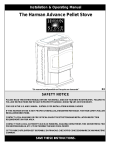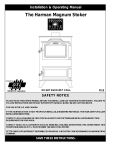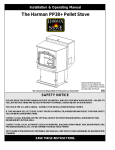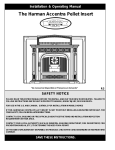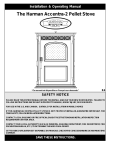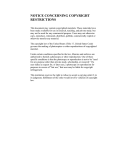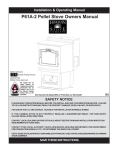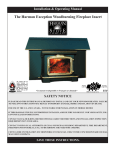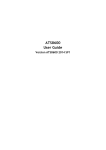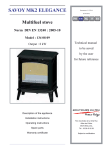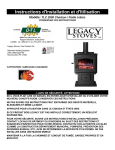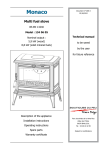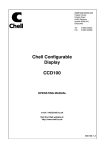Download Harman Stove Company TLC 2000 Stove User's Manual
Transcript
HARMAN TLC 2000 OPERATOR'S MANUAL FOR USE IN THE U.S. AND CANADA SAFETY NOTICE: IF THIS HARMAN TLC 2000 STOVE IS NOT PROPERLY INSTALLED, A HOUSEFIRE MAY RESULT. FOR YOUR SAFETY, FOLLOW INSTALLATION DIRECTIONS. CONTACT LOCAL BUILDING OR FIRE OFFICIALS ABOUT RESTRICTIONSAND INSTALLATION INSPECTION REQUIREMENTS IN YOUR AREA. R6 TLC 2000 Coal Stove INDEX Specifications 4 Operation 6 Building a Fire 7 Maintenance 11 Installation 13 Chimney System 15 Parts List 19 Parts Diagram 20 Warranty 21 Please read this entire manual before you install and use your new room heater. Failure to follow instructions may result in property damage, bodily injury, or even death. NOT TESTED FOR MOBILE HOME INSTALLATIONS. SAVE THESE INSTRUCTIONS Harman Stove Company 352 Mountain House Road Halifax, PA 17032 U.S.A. 2 TLC 2000 Coal Stove WARNINGS Carbon Monoxide (CO) Awareness Carbon monoxide referred to as CO, is a colorless, odorless gas that is produced during combustion of coal and other fuels. CO fumes are toxic and can be fatal. The TLC 2000 is a closed loop system specially designed to prevent the escape of CO and other combustion products from the stove. Even though this stove is designed to be as safe as possible, it is important that you install a CO detector. This is true for oil, gas, or wood as well. CO is heavier than air. This causes accumulation to occur at the floor first. Therefore, it is best to install the detector at table top level or lower rather than on the ceiling like a smoke detector. CO detectors are very sensitive and may sound an alarm for fumes other than CO or CO from sources other than the stove such as car or lawn mower exhaust. If the alarm sounds 1. Increase ventilation by opening windows or doors. 2. Make sure the stove doors and hopper lid are closed and latched. 3. Check stove for electrical power and normal operation. 4. Check for false alarm. (Never sleep in the same room with any coal burning stove.) Never use gasoline, gasoline-type lantern fuel, kerosene, charcoal lighter fluid, or similar liquids to start or “freshen up” a fire in this heater. Keep all such liquids well away from the heater while it is in use. 3 TLC 2000 Coal Stove Specifications - Harman TLC 2000 Weight 375 lbs Flue Size 6 inch Log Length Recommended 16" with 18" Max Heating Capacity 1,900 sq. ft. Blower Size (optional) 135 variable speed 4 TLC 2000 Coal Stove Top Load Door 5 Clean-out Cover Top Load Opening Top Load Door Arm Glass Door Wood Air Control Grates Side Shield Coal Air Control Removable Shaker Handle Front Load Door Latch Ash Door Latch Ash Door TLC 2000 Coal Stove 6 Operation The Stove Fuels for USA Doors Wood: Your stove has a large glass-paneled door for loading and fire viewing, a separate smaller door for removing ashes and a top loading door. To open the glass door, turn the handles clockwise and pull out; to close the door, return the handles to an open 9 o'clock closed 6 o'clock, and push in to engage the latch while turning the handles counterclockwise. To open the ash door, lift up the handle and pull out. Close the door by pushing in and pushing the handle all the way down. To open the top load door move the wooden knob located on the left side of the stove front and upward until it locks the top open. Page 6. If the latch in either of your TLC 2000 doors needs adjustment, follow the instructions given in the Maintenance section. All doors must be closed while the stove is in normal operation, and the gaskets routinely examined for wear and replaced when necessary. The glass door may be left open and the opening covered with a screen when operating as a fireplace. Good door seals are important for maintaining control of the stove. Operating the stove with the ash door open, or with a door inadequately sealed, could create a serious overfiring condition (discussed later in this section). Wood may be burned in the TLC2000 for the purpose of igniting coal. Wood may also be burned with the glass door open and a screen in place to prevent sparks from escaping. This provides a real open fire atmosphere. Coal: Anthracite coal, pea or nut size, is the primary fuel for which the TLC2000 is designed. Bituminous coal may also be burned but the results will vary do to the variation in bituminus coal from state to state. Fuels for Canada Wood: Wood may be burned as a primary fuel. This is because U.S. EPA regulations do not apply in Canada. Wood may also be burned with the glass door open and a screen in place to prevent sparks from escaping. Coal: Anthracite coal, pea or nut size, may also be burned as a primary fuel for the TLC2000. Bituminous coal may also be burned but the results will vary do to the variation in bituminus NEVER OPERATE WITH MORE THAN ONE coal from province to province. DOOR OPEN AT A TIME The glass used in your TLC 2000 is manufactured to exact standards to withstand the high heat of the fire, but like all glass, it must be treated with common sense and care. Never abuse the glass by slamming the door shut or striking the glass with a heavy object. If the glass is broken or damaged, do not operate the stove until it has been replaced (See instructions in the Maintenance section.) Grates The Harman TLC 2000’s unique grate system consists of two Cast ir on gr ates lin ked together to o perate simaltainiously when the external shaker handle is moved. The purpose of the grate system is to to support the coal bed while air flows up through the grates to the burning coal. The grates are also used to remove ashes from the bottom of the coal bed while the fire is burning. This is accomplished by shaking the shaker lever back and forth with short choppy strokes. This causes the ashes to fall through the grates into the ash pan. It is the special design of the Harman Grates that allows longer intervals between refueling and shaking the grates. Harman Grate System TLC 2000 Coal Stove 7 Air Controls Coal The primary air control for coal burning is a knob located on the bottom door. Sliding the knob to the left provides less air for a smaller fire. Sliding the knob to the right provides more air for a larger fire.When burning wood this knob should be all the way to the left, closed. Wood WOOD COAL WOOD The primary air controls for wood burning are located on each side as shown below and on page 4. Both controls should be adjusted equally. Air from these controls also provides a curtain of air across the glass to keep it clean. Move the controls down for less heat and up for more heat. When burning coal these controls should be in the down position. CAUTION: The wood controls are hot. Use the removable shaker handle or gloves to adjust these controls. Coal must have air coming up through the coal bed in order to burn. Some air over the top of the coal helps burn gases. A small amount of air enters the top of the coal fire when the wood controls are in the down position. Wood burns with top or bottom air; however, top air coming down across the glass to form an air curtain works best and keeps the glass clean. This is why it is recommended that the coal control be positioned to the left for wood burning. Building and Maintaining a Wood Fire Never use gasoline, gasoline-type lantern fuel, kerosene, charcoal lighter fluid, or similar liquids to start or “freshen up” a fire in this heater. Keep all such liquids well away from the heater while it is in use . Crumple up six to eight sheets of news paper and place in the firebox. Next place pieces of dry wood 3/4 inch maximum diameter on top of the paper, Next place several 1 " - 2" split pieces of dry wood on top, followed by a few 2" - 3" split pieces. Set the wood air controls at the maximum heat output setting, all the way up. Place the knob on the bottom door to the left. These settings will allow the glass to stay clean as you build your fire. The coal knob may be moved to the right to speed the ignition process but the glass may get dirty. Ignite the paper and allow the fire to burn until a good charcoal bed, 2" - 3" (50 mm - 80 mm) is formed; (You may need to leave the ash door open a crack to get the blaze going properly, but never leave the stove unattended.) Add more wood to create a deeper charcoal base 3" to 4". Once the charcoal bed is established you may add a full TLC 2000 Coal Stove Remove Cleanout Plate To Burn As A Fireplace Stove 8 load of dry wood. After adding the fuel, leave air setting at maximum for 5 to 15 minutes. Then adjust the air controls and blower speed for the desired heat output. Reloading. Once you have prepared and maintained a thick charcoal bed, you should be able to reload the stove, allow some burning at the maximum air setting, and reset the air control in about five minutes. Select hardwoods if possible, as they are heavier and contain more heating capacity (BTU’s) per load than do softwoods. Wood should be split and stored under cover for “seasoning” - a year is recommended. Your stove is not an incinerator - do not burn garbage, painted or treated wood, plastic, or other debris. Keep the area around the stove free from clutter. Keep all combustibles, including fuel, beyond the code-required clearance distance (48" or 1215 mm in the U.S., 1525 mm or 60" in Canada). Never store fuel in front of the stove where it could interfere with door operation, safe loading, and ash removal. Blower. To regulate the speed of the optional convection blower, adjust the control from low to high by turning the knob located on the blower cord. Removing Wood Ashes. Always wear gloves to remove the ash pan Lift the latch on the ash door and open. Pull the ash pan out by the handle. Lift the handle to the vertical position to carry the ashes to a disposal location. Close the ash door while you are disposing of the ashes. The fire will get very hot if the bottom door is left open even for a short period. Replace the ash pan. Remove ashes from the fire chamber periodically by shaking the grates. Wood burns best with an ash bed under the wood; therefore, do not shake all of the ashes down. Never let the ashes build up to over 3" in depth. Excessive ash buildup can prevent proper venting of exhaust gases. Also do not overfill the ash pan. Ash buildup between the ash pan and the grates can cause them to overheat and wear out prematurely. Operating as a Fireplace. The TLC 2000 is tested and approved to be burned with the front load door open. In this mode of operation you get a true fire sound as well as appearance. Due to the crackling and popping of burning wood it is necessary to place the optional screen over the door opening. This prevents sparks from entering the room just like a screen over a fireplace. The clean-out plate should be removed to burn as a fireplace. This is done by lifting up on the tab on the front of the plate. To install the screen, open the glass door and place the screen over the door opening. Push on the screen until the two spring clips snap into place. To remove the screen, pull on the gold handle. TLC 2000 Coal Stove 9 Building and Maintaining a Coal Fire Build a wood fire as described but instead of adding larger wood, limit the size to about 2" in diameter. Add enough 2" wood that the firebox floor is covered with burning wood. After the wood is burning well for about five minutes, put the wood air controls in the down position and slide the coal air control to the right. This makes the primary air flow up through the grates as is required for coal burning. Next add a layer of coal on top of the wood. Continue burning until the layer of coal is turning red and igniting. It is possible to speed this process by opening the ash door, but never for more than five minutes at a time. Operation with the ash door open for more than five minute will overfire the stove and may cause damage to the stove. Never let the stove unattended with the ash door open. After the layer of coal is burning a second layer may be added. After the second layer is burning more layers may be added. Do not add coal above the firebricks or grate bars. Add Even Layers by pouring evenly across coal bed The stove is hot while in operation. Keep children, clothing and furniture away. Contact may cause skin burns. As you begin to operate your stove at higher temperatures, you will notice a “hot” or unpleasant smell; this is just the paint going through the curing process, and will disappear after a few fires. 6 4 3 4 2 1 5 1. Grates 6. Grate Bars 2. Ashes On Grates 3. Partly Burned Coal 4. Fresh Coal 5. Ashes In Ash Pan Overfiring Avoid overfiring your stove, a potentially hazardous situation which can lead to overheating of combustible materials, damage to the stove, and in extreme cases, cause a fire. Overfiring is caused by: 1. Too much air flowing through the stove too quickly. 2. You may have positioned the primary air control level too far to the right. 3. Inadvertently left the bottom door open or 4. Not kept up with routine maintenance, such as checking door gaskets for wear. Overfiring results in excessive fuel consumption, and may cause parts of the stove or chimney connector to glow red. If you notice signs of overfiring, reduce the air supply to the fire, and review the Maintenance section in this manual. Never leave the stove unattended if either the ash or load door is open. Overfiring may result. In the event of a chimney fire, call your local fire department; make sure everyone is safely out of the house. Reduce the air intake of the stove as much as possible using the air control lever. Do not throw water on the fire; this can cause stove damage and create an even more dangerous situation. Have your chimney professionally cleaned and inspected before resuming burning in your stove. TLC 2000 Coal Stove Handle Ash Pan Handle 10 Disposal of Ashes. The TLC 2000 was designed to provide access to the ash pan without the need for opening the main door. Wearing heavy protective gloves, open the ash door and remove the ash pan by pulling it forward by the handle. Close the ash door before taking the ashes outside for safe disposal. A good time to empty the ash pan is before loading. This ensures that the ashes will be cold and safer to handle than directly after shaking the ashes down or tending the fire. Ashes should be placed in a metal container with a tight fitting lid. The closed container of ashes should be placed on a noncombustible floor or on the ground, well away from all combustible materials, pending final disposal. If the ashes are disposed of by burial in soil or otherwise locally dispersed, they should be retained in the closed container until all cinders have thoroughly cooled. Never use the ash disposal container for other trash. Wood ash can be added to your garden or compost. Refueling Open the coal air control to the maximum postion by sliding it to the right. Allow the fire to burn vigorously for several minutes. Shake the grates with short choppy strokes until the first red coals fall into the ash pan, then stop! Add coal to the top of the coal bed. It is good to let an edge of red coal exposed to help ignite the gases comming off of the coal. These gasses will produce a blue flame. The coal air control may be returned to the desired setting. Cooking Grill Stainless Steel Cooking Grill (Optional ) The cooking grill can be used for open fire grilling over anthracite coal or wood. To install the grill place the handle in the grill as shown at left. The grill can now be lifted and positioned in the opening on top of the stove as shown below left. Caution: Cooking Grill May Be Hot. Always wear gloves when handling the grill. Cooking on anthracite coal produces flavor similar to a gas grill. Cooking on wood produces many flavors depending on the type of wood used. More flavor is added when cooking is done with the top closed. This causes the heat and smoke to circle around the food. As with any cooking, the amount of heat and length of time it is cooked must be experimented with for best results. TLC 2000 with cooking grill in action TLC 2000 Coal Stove 11 Maintenance Like all fine equipment, your TLC 2000 requires some routine maintenance and inspection. Follow the guidelines in this section to guarantee safe, efficient operation. The Stove Surface The stove’s exterior surface should be dusted periodically with a soft cloth. For more thorough cleaning, wait until the stove is cool before using a damp cloth to clean any blemishes. The Door The gold plated front door should never be buffed or polished. Abrasive cleaners and metal polishes will remove the plating and therefore should never be used. If the door needs to be cleaned, wait until the stove is completely cool, then use a sponge, soap and water to gently remove dirt and stains. Before relighting the stove, remove all soap residue and wipe dry. Controls To avoid a rust build-up on the inner surfaces of the controls, work the controls back and forth several times, during the summer, or any prolonged period when you are not using your stove. Glass Gasket Glass Hold Down Clips and Bolts The Fire Chamber The inside of the fire chamber should be examined for damage to the firebrick lining material, and grates. If any bricks have been damaged, replace them with Harman Stove Company replacement parts. Glass - Replacement If the stove’s glass is cracked or broken, you must replace it before operating your stove. Remove pieces carefully. Replace glass only with Harman Stove Company replacement glass panels; do not use substitutes. To replace the glass panel(s), you will need to remove the door. To do this, open the door, lift it straight up and place it on a soft surface. Carefully remove damaged glass, gasket material, and hold down clips (set aside). Referring to the diagram, note how the various components of the door system fit together. Lay the load door face down on the soft surface, and install the self adheasive 1/4"” gasket material around the front face of the glass. Set the glass pane and gasket gently onto the door. Install the hold down clips and tighten with bolts as shown. Reinstall door on stove. Glass - Cleaning Sometime it will be necessary to clean accumulated ash from the glass surface; allowing this ash to remain on the glass for long periods can result in “etching” due to the acidity of the ash. The creosote which accumulates Door on the glass should burn off during your hot fires. Never clean the glass while it is hot, and do not use abrasive substances. Wash the surface with cool water, and rinse thoroughly. You may wish to use a non-abrasive cleaner specifically designed for use on stove glass. In any case, dry thoroughly before relighting your stove. TLC 2000 Coal Stove 12 Gaskets Gaskets are used on the doors and top lid of the TLC 2000. You must check these gaskets from time to time, and replace them when necessary. The gaskets are made of fiberglass of different sizes (obtainable from Harman Stove Dealer) and are fixed in place with a high temperature stove gasket cement. To change a gasket, first remove the worn fiberglass and clean the area with a wire brush. Also clean any other surfaces that come into contact with the gasket. Place a small bead of cement in the area under the gasket, then press new gasket material into the channel; do not overlap the ends. Seat the gasket firmly by applying pressure when possible; for example, after changing the door gasket, close the door. Allow the cement to dry before using your stove. Gaskets are located: On the doors to provide airtight closure. On the lid. Handle The handle on the front door of your TLC 2000 is attached to threaded shafts. After a period of time, you may find that the front door does not close as firmly as when your stove was new. This is due to a natural compression of the gaskets. To tighten the seal, open the door and rotate the handle one full turn counterclockwise or bend the latch plate on the stove. Blower The optional blower on your TLC 2000 stove requires very little maintenance. You should, however, keep the air inlet and the motor free of dust and dirt. TLC 2000 Coal Stove 13 Installation DO NOT INSTALL IN A SLEEPING ROOM Assembly Blower ( Optional ) Bolt the blower to the bottom rear of the stove with four 1/4-20 bolts. Tighten the bolts, but do not overtighten. The power cord for the blower must be connected to a grounded outlet, and may not be routed above, under, over or around the stove itself. Blower Variable Speed knob Top Air Grill Top Air Grill ( Optional ) The top air grill must be installed before the chimney connector is installed. To install simply place the top air grill over the flue out let and position as shown at left. It is held in place by gravity. The top air grill is a decorative option that does not add or subtract from the performance of the stove. TLC 2000 Coal Stove 14 Floor Protection Parallel versus Corner Installations In all installations, the area under and around the stove must be protected from falling ash and live coals. The floor protector must be of noncombustible material, and positioned as shown in the accompanying illustration. The guidelines for floor protection are: 1) completely under the stove and any horizontal runs of connector; 2) 2"(50mm) in back of the stove; 3) 8"(200 mm) to each side; 4) U.S. 16"(405 mm) in front of the doors; Canada 18" (450 mm) in front of the doors. A parallel installation is one in which the back and sides of the stove are parallel to the walls behind and to the side of the stove. A corner installation is one in which the back of the stove is positioned diagonally across a corner of the room. Each installation requires its own set of clearances. For parallel installations, the required clearance distances from the stove are: 1) to the side wall, 18" ; 2) to the back wall, 16". From the chimney connector to the wall, 18" and to the ceiling, 36". Fireplace installations must meet these same clearance requirements; specifically follow these guidelines for mantel and trim clearances. For corner installations, the clearance distances from the stove are 12" from each corner of the stove measured straight to the nearest combustible material. From the front of the stove, clearance to combustible materials such as furniture, curtains, fuel, etc., is: 48" in the U.S. and 60" in Canada. Clearances Clearance is the empty space required between the stove or chimney connector to the nearest combustible surface or object, such as walls, ceilings, floors, or furniture. Clearance distances may only be reduced by using methods approved by either the CAN/CSA B365 standard (Canada) or NFPA 211 (U.S.) Contact your building authority for information if you are interested in reducing clearance distances other than those presented here. Wall 16" Wall 12" 18" 2" Wall Wall 18" 8" 12" 8" 16" Floor Protector Floor Protector TLC 2000 Coal Stove The Chimney System Creosote When wood is burned slowly, it produces tar and other organic vapors, as well as soot, which combine with expelled moisture to form creosote . The creosote vapors condense in the relatively cool chimney flue (associated with a slow burning fire). As a result, creosote accumulates on the flue lining. When ignited, this creosote can result in an extremely hot fire. The chimney should be inspected at least once every two months during the heating season to see if any creosote build-up has occurred. Checking your chimney and chimney connector more frequently, especially while you are getting used to your stove, is recommended. To inspect this system, let the stove cool. Using a flashlight and mirror, check the interior of the chimney connector, and the chimney itself. If a significant layer of creosote or soot has accumulated (1/8"” or 3 mm) it should be removed to reduce the risk of a chimney fire. To clean deposits from the surface of the connector, use a stiff wire brush after dismantling the connector assembly. To clean the chimney, use a specially designed brush sized to fit your particular flue opening, or call an established chimney cleaning service. At the end of the heating season, perform a thorough examination of your chimney system, and have it repaired if necessary. Draft Draft is widely misunderstood. It is important that you, the stove operator, realize that draft is a variable effect, not a given quantity. Stoves and chimneys do not have draft, yet draft is the key to your stove’s performance. Draft is a force, produced by an operating stove and the chimney to which it is attached. It is created by hot gases rising up the chimney, creating a pressure difference between the inside of your home and the outside air. It continually moves fresh combustion air into the stove, and hot exhaust gases out of the stove; without this constant flow, the fire will go out. Other factors, such as barometric pressure, winds, the airtightness of the home, the total inside chimney volume, chimney height and the presence of venting devices such as exhaust fans also play a role in maintaining an adequate draft. Low barometric pressures, super insulated homes and exhaust fans can reduce draft; winds can play havoc with draft; and too large or too small a chimney volume can cause reduced draft due to the excessive cooling or not enough room to vent exh au st gases q uick ly. Some signs of inadequate draft are smoking, odor, difficulty in maintaining the fire, and low heat output. Overdraft can be caused by a very tall chimney even if it is the recommended size, and can cause overfiring of your stove. Signs of an overdraft include rapid fuel consumption, inability to slow the fire, and parts of the stove or chimney connector 15 glowing red. It is important that you follow the chimney guidelines in this manual, including size, type, and height to avoid draft problems. When installed and operated according to this manual, the TLC 2000 will produce enough hot gases to keep the chimney warm so that adequate draft is maintained throughout the burn cycle. Chimney Connectors In general, following these guidelines will ensure compliance with all national and provincial codes; prior to beginning your installation, check with your local building code official to check on additional local regulations which may influence the design and placement of your venting system. The Harman TLC 2000 may be installed with (150 mm) 24 gauge chimney connector pipe. Size of the connector should correspond to the size of the flue collar opening. Do not use makeshift compromises. No part of the chimney connector may pass through an attic or roof space, closet or other concealed space, or through a floor or ceiling. Whenever possible, avoid passing the connector through a combustible wall; if you must, use an approved wall pass-through, described later in this section. Assemble the connector beginning at the flue collar, with the crimped ends pointing towards the stove (to keep debris and creosote flakes inside the system). Each joint, including the one to the stove’s flue collar and the one to the chimney itself should be secured with at least three sheet metal screws. Screws may be a maximum of 3 inches apart. A 1-1/4" (30 mm) overlap is required at each joint, including the flue collar attachment. No more than two 90 degree elbows should be used, and the total length of connector should not exceed 10 feet (3 m). All horizontal runs of connector must have a minimum upward slope of 1/4"(6 mm) per foot (20 mm per meter). Wall Pass-throughs Occasionally it is necessary to pass the chimney connector through a combustible wall to reach the chimney. Depending on your local building codes, and the pertinent provincial or national codes, there are several choices for accomplishing this safely. Before beginning your installation, contact local officials, and also the chimney connector and chimney manufacturer for specific requirements. Canada. Three methods are approved by the Canadian Standards Association. The diagram shows one method requiring an 18"(450 mm) air space between the connector and the wall. It allows use of one or two covers as described in the diagram. The two other methods are described in detail in the current issue of CAN/CSA B365, the national standard. United States In the U.S., the national code is NFPA 211. While many localities adopt this standard, be sure to check with local authorities before beginning your installation. TLC 2000 Coal Stove The NFPA (National Fire Protection Association) permits four methods for passing through a combustible wall. A commonly used method to pass through a wall directly to a masonry chimney is to clear a minimum 12"(300 mm) around the entire chimney connector, and fill it with brick masonry which is at least 3.5"(90 mm) thick. A fireclay liner, minimum 3/8" (9 mm) wall thickness must run through the brick wall to the chimney liner (but not beyond the inner surface of the liner). It must be cemented in place with refractory cement. This method is illustrated. For details on the other three options, refer to the most recent edition of the NFPA 211 code. The Chimney The TLC 2000 must be installed into a chimney approved for use with solid-fuel appliances. In the U.S., the TLC 2000 must be connected to (1) a prefabricated chimney complying with the requirements for Type HT chimneys in the Standard for Chimneys, Factory-Built, Residential Type and Building Heating Appliances, UL 103, or (2) a code-approved masonry chimney with a flue liner. In Canada, the TLC 2000 is listed for use with prefabricated chimneys tested and listed to the high temperature (650 degrees C) chimney standard, ULC S-629, or with a code approved masonry chimney. The minimum recommended height for any chimney is 16 ft (4.8 m) above flue collar height. A round flue (either masonry or approved prefabricated), of either 6" (150 mm), 7" (180 mm) or 8" (200 mm) may be used. For square or rectangular masonry chimneys, nominal sizes of 8" x 8"or 8"x 12" (200 mm x 200 mm, 200 mm x 300 mm) may be used. 16 TLC 2000 Coal Stove 17 Codes require that solid-fuel chimneys extend 3 ft (0.9 m) above the point at which they exit from the roof, provided that no part of any structure is within the top of the chimney, then the chimney must extend 2 ft (6 m) above the highest point with the 10 ft (3 m) radius top height. If there is not ten feet of clearance from the top of the chimney, then the chimney must extend 2 ft (6m) above the highest point with the 10 ft (3m) radius. Do not connect this unit to a chimney flue servicing another appliance. NOTE: The restriction of not venting more than one appliance to the same flue applies to the U.S. specifically. While it is not recommended that you use the same chimney for more than one appliance, in Canada certain exceptions may be made. Be sure to contact your building code inspection official to see if this option is allowed in your area, and to find out the specific requirements for such an installation. Existing Masonry Chimneys If you plan on using a pre-existing masonry chimney, have it thoroughly inspected and cleaned. Any faults which make the chimney unsafe and unusable must be repaired prior to use. These can include improper height, structural defects, blockages, inadequate clearance to combustibles, unsealed openings into other rooms of the house, signs of creosote or smoke leakage, a loose or absent cleanout door, or absence of a liner. Do not connect to any air distribution duct or system Venting to a Masonry Chimney When connecting to a masonry chimney, several provisions are standard. First, whether the chimney connector is vented to the chimney through a thimble or a breech pipe, neither must pass beyond the inner surface of the chimney liner, and both must be firmly cemented in place with refractory cement. (A thimble is a masonry pipe which is inserted through the chimney wall, and is frequently the preferred method; a breech pipe is a piece of steel pipe used the same way.) In Canada, a breech pipe has ridges or protrusions to lock it firmly into the refractory cement. In either case, the chimney connector vents to the chimney through the thimble or breech pipe. Using a thimble, the connector slides completely inside the masonry to the inner edge of the flue liner, and may be easily removed for chimney and connector inspection. A breech pipe must extend at least 2" (50 mm) into the room, so the connector can be attached with sheetmetal screws. Venting to a Masonry Fireplace Chimney In some situations, a code compliant chimney originally used for a masonry fireplace may be used to install your TLC 2000. In addition to the requirements found in the previous paragraphs, it is important to be aware that all clearances must be met, including those from the chimney connector to combustibles — 18" (360 mm) to sides and 18" (450 mm) to ceiling. Do not forget to include floor protection in your plans. (See Clearances and Floor Protection in this section.) Since many fireplaces have exposed wooden mantels and trim, pay special attention to the clearances necessary to these materials. If your fireplace chimney is behind a combustible wall, you must use an approved wall pass-through system to gain access to the masonry chimney. The chimney connector must enter the chimney at a place where it is lined, and the fireplace must be made inoperable. For example, you might remove the damper, replacing it with a secure, airtight, noncombustible seal (removable for inspection); this also satisfies the requirement that no room air must be allowed to enter the chimney. TLC 2000 Coal Stove Installing to a Prefabricated Chimney When venting your TLC 2000 using a prefabricated chimney, be sure to contact local building code authorities, and to follow the manufacturer’s instructions exactly. Use only the manufacturer’s parts; do not use makeshift installation techniques. All prefabricated chimneys must be tested to either the U.S. or Canadian high-temperature standards, UL 103 or ULC-629. Warning: Do not install in sleeping room. The Harman TLC 2000 was tested with fuel door open and closed. If you operate with doors open, open the by-pass and put a screen over the opening. Do not burn any fuel other than wood, such as charcoal, which can cause increased carbon monoxide production or overfiring. Never use highly volatile substances in your stove, such as gasoline, which could cause an explosion. When solid fuels are burned completely, they produce water and carbon dioxide. However, in long slow burns, a substantial amount of carbon monoxide may be produced. If allowed to build up, carbon monoxide (which is odorless) can prove fatally poisonous. Proper ventilation and draft will prevent this from happening. If you smell smoke, turn up the air control lever setting, and thoroughly ventilate your dwelling. During future burns, be careful not to overload the stove with fuel, so you will not be tempted to constantly operate at a low air control setting. Other causes of poor ventilation or draft are icing, exhaust fans, a blocked outside air inlet, and room air starvation. If your stove is sluggish and you get occasional odor, check these possibilities and increase the air flow in your home. Caution: Always wear fire-resistant gloves to operate the stove. The air control is hot while in operation. 18 TLC 2000 Coal Stove 19 19 TLC 2000 Parts List 1. 2. 3. 4. 5. 6. 7. 8A. 8B. 9. 10A. 10B. 11A. 11B. 12. 13. 14. 15. 16A. 16B. 17. 18. 19. 20. 21. 22. 23. 24. 25. 26. 27. 28. 29. 30. 31. 32. 33. 34. 35. 1-10-08074 2-00-852129 1-10-08127 1-00-08710 3-44-10050 2-00-852149 2-00-852153 2-00-852140-2 2-00-852140-1 2-00-852141 2-00-852145 2-00-852144 1-10-08159A 1-10-05165 3-43-4722386 1-10-08690 1-10-08718 2-00-852132 2-00-852135 3-31-08739 2-00-852133 2-00-854148 3-40-08746 2-00-852136 2-00-08725 2-00-08726 3-40-900450125 2-00-852119 3-00-00208 1-00-08643 1-10-852166 2-00-852139 1-10-852138 2-00-852160 3-40-05228 1-10-08722 2-00-852128 2-00-852147 3-31-08724 TLC Rear Top TLC Rear Hinge (2 per unit) TLC Front Top Assembly TLC-2000 Top Air Grill Assembly (Option) 1 1/2" Tadpole gasket TLC Gasket Plate TLC Cleanout TLC Airwash Adjuster - Right TLC Airwash Adjuster - Left TLC Right Side Shield TLC Coal Bar (3 per unit) TLC Coal Bar Holder (2 per unit) TL Cast Load Door - Roped TL Gold Load Door - Roped TL Brass Ash Lip Trim TLC Ash Pan Assembly TLC Ash Door Assembly TLC Bottom Slide Rail TLC Airslide 5/16 - 18 x 2 1/2 All Thread TLC Top Slide Tail TLC Airslide Cover TLC Airslide Knob TLC Ash Door Latch TLC Long Brick Support (2 per unit) TLC Side Brick Support (2 per unit) 9 x 4 1/2 x 1 1/4 Firebrick (11 per unit) TLC Grate Link Long Grate Link (2 per unit) TLC-2000 Blower Option TLC Shaker Handle Weldment TLC Left Side Shield TLC Air Jacket Weldment TLC Heat Shield TL Wooden Knob TLC Damper Linkage Arm Weldment TLC Top Lift Arm With Notch TLC Brick Backer (2 per unit) 1/4 & 3/8 Dowel Pin (2 per unit) TLC 2000 Coal Stove 1 2 20 4 3 5 2 32 30 6 33 7 31 8A 29 9 8B 11A 10A 10B 11B 28 27 12 25 13 15 24 16A 16B 26 14 19 23 18 20 17 22 34. Brick Backers (2) 35. 1/4 & 1/8 Dowel Pins (2) 21 21 HARMAN GOLD WARRANTY 6 YEAR TRANSFERABLE LIMITED WARRANTY (Residential) 1 YEAR LIMITED WARRANTY (Commercial) Harman Stove Company warrants its products to be free from defects in material or workmanship, in normal use and service, for a period of 6 years from the date of sales invoice and for mechanical and electrical failures, in normal use and service, for a period of 3 years from the date of sales invoice. If defective in material or workmanship, during the warranty period, Harman Stove Company will, at its option, repair or replace the product as described below. The warranty above constitutes the entire warranty with respect to Harman Stove Company products. HARMAN STOVE COMPANY MAKES NO OTHER WARRANTY, EXPRESSED OR IMPLIED, INCLUDING “ANY” WARRANTY OF MERCHANTABILITY, OR WARRANTY OF FITNESS FOR A PARTICULAR PURPOSE. No employee, agent, dealer, or other person is authorized to give any warranty on behalf of Harman Stove Company. This warranty does not apply if the product has been altered in any way after leaving the factory. Harman Stove Company and its agents assume no liability for “resultant damages of any kind” arising from the use of its products. In addition, the manufacturer and its warranty administrator shall be held free and harmless from liability from damage to property related to the operation, proper or improper, of the equipment. THERE ARE NO WARRANTIES WHICH EXTEND BEYOND THE DESCRIPTION ON THE FACE HEREOF. THESE WARRANTIES APPLY only if the device is installed and operated as recommended in the user’s manual. THESE WARRANTIES WILL NOT APPLY if abuse, accident, improper installation, negligence, or use beyond rated capacity causes damage. HOW TO MAKE A CLAIM - Any claim under this warranty should be made to the dealer from whom this appliance was purchased. Then contact is made with manufacturer, giving the model and serial numbers, the date of purchase, your dealer’s name and address, plus a simple explanation of the nature of the defect. Extra costs such as mileage and overtime are not covered. Nuisance calls are not covered by these warranties. THIS WARRANTY IS LIMITED TO DEFECTIVE PARTS - REPAIR AND/OR REPLACEMENT AT HARMAN STOVE COMPANY’S OPTION AND EXCLUDES ANY INCIDENTAL AND CONSEQUENTIAL DAMAGES CONNECTED THEREWITH. WARRANTY EXCLUSIONS: Failure due, but not limited to, fire, lightning, acts of God, power failures and/or surges, rust, corrosion and venting problems are not covered. Damage and/or repairs including but not limited to; remote controls, filters, fuses, knobs, glass, ceramic brick panels, ceramic fiber afterburners, door packing, tile, ceramic log sets, paint, batteries or battery back-up and related duct work are not covered. Also excluded from this warranty are consumable or normal wear items including but not limited to; flame guides, grates, coal bars, afterburner hoods, fire brick, gaskets. Additional or unusual utility bills incurred due to any malfunction or defect in equipment and the labor cost of gaining access to or removal of a unit that requires special tools or equipment are not covered. Maintenance needed to keep the stove in “good operating condition” is not covered. This includes, but is not limited to, cleaning, adjustment of customer controls and customer education. Labor, materials, expenses and/or equipment needed to comply with law and/or regulations set forth by any governmental agencies are not covered. This Warranty provides specific legal rights and the consumer may have other rights that vary from state to state. In the event of change in ownership, the remaining portion of this warranty may be transferred to the new owner by sending the new owner information to the Harman Stove Company. PLEASE READ THE LITERATURE BY THE MANUFACTURER FOR THE VARIOUS ACCESSORY DEVICES. THE MANUFACTURER WARRANTS THESE ACCESSORY DEVICES, NOT HARMAN STOVE COMPANY OR THEIR WARRANTY ADMINISTRATOR. FURTHERMORE, THESE ACCESSORY DEVICES MUST BE INSTALLED AND USED ACCORDING TO THE RECOMMENDATIONS OF THE MANUFACTURER. REMEDIES - The remedies set forth herein are exclusive and the liability of seller with respect to any contract or sale or anything done in connection therewith, whether in Contract, in tort, under any warranty, or otherwise, shall not, except as herein expressly provided, exceed the price of the equipment or part of which such liability is based. CLARIFY - The above represents the complete warranty, which is given in connection with stoves, manufactured by Harman Stove Company. No other commitments, verbal or otherwise, shall apply except by a written addendum to this warranty.





















